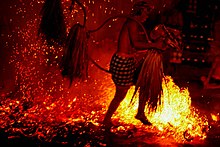This article needs additional citations for verification. (October 2015) |
 | |
| Native name | ᬲᬂᬳ᭄ᬬᬂ (Balinese) Tari Sanghyang (Indonesian) |
|---|---|
| Genre | Sacred dance |
| Instrument(s) | Gamelan, Suling, Kendhang |
| Inventor | Balinese |
| Origin | Indonesia |
| Three genres of traditional dance in Bali | |
|---|---|
 | |
| Country | Indonesia |
| Reference | 617 |
| Region | Asia and the Pacific |
| Inscription history | |
| Inscription | 2015 |
 Wali Sacred Dances (Rejang, Sanghyang Dedari, Baris Upacara), Bebali Semi sacred Dances (Topeng Sidhakarya/Topeng Pajegan, Gambuh dance drama, Wayang Wong dance drama), Balih-balihan Entertainment Dances (Legong Kraton, Joged Bumbung, Barong Ket) | |
| Sanghyang |
|---|
|
| Burma |
| Cambodia |
| Indonesia |
|
| Laos |
| Malaysia |
| Philippines |
| Singapore |
| Thailand |
|
| Vietnam |
Sanghyang (Balinese: ᬲᬂᬳ᭄ᬬᬂ) is a traditional sacred Balinese dance originated from the Indonesian island of Bali. It is based on the premise that an unseen force enters the body of an entranced performer. The force, identified as hyang, is an important type of spiritual entity in ancient Indonesian mythology.
The sanghyang dances are considered sacred ritual dances and are performed exclusively at Balinese religious ceremonies.[1][need quotation to verify]

